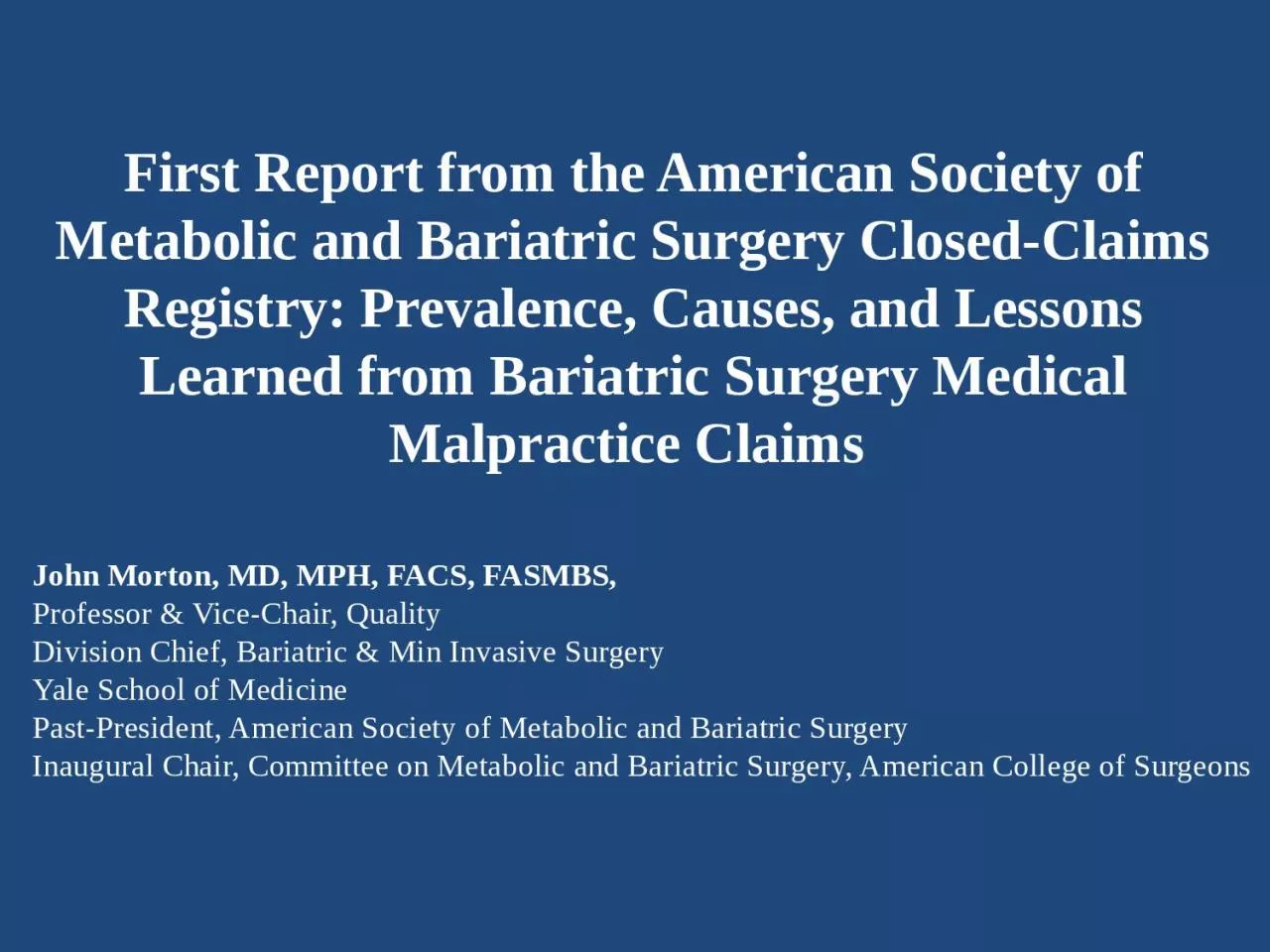

John Morton MD MPH FACS FASMBS Professor amp ViceChair Quality Division Chief Bariatric amp Min Invasive Surgery Yale School of Medicine PastPresident American Society of Metabolic and Bariatric Surgery ID: 1041736
Download Presentation The PPT/PDF document "First Report from the American Society o..." is the property of its rightful owner. Permission is granted to download and print the materials on this web site for personal, non-commercial use only, and to display it on your personal computer provided you do not modify the materials and that you retain all copyright notices contained in the materials. By downloading content from our website, you accept the terms of this agreement.
1. First Report from the American Society of Metabolic and Bariatric Surgery Closed-Claims Registry: Prevalence, Causes, and Lessons Learned from Bariatric Surgery Medical Malpractice Claims John Morton, MD, MPH, FACS, FASMBS, Professor & Vice-Chair, QualityDivision Chief, Bariatric & Min Invasive SurgeryYale School of MedicinePast-President, American Society of Metabolic and Bariatric SurgeryInaugural Chair, Committee on Metabolic and Bariatric Surgery, American College of Surgeons
2. DisclosuresJohn M. Morton – Ethicon , Olympus, Novo Nordisk- Consultant
3. BackgroundThe landmark Institute of Medicine Report To Err is Human highlighted the societal need to improve patient safety. Medical malpractice claims are often offered as a method of addressing lapses in patient care.
4. BackgroundBariatric surgery has experienced a tremendous improvement in patient outcomes. Despite excellent patient safety profile, malpractice coverage for bariatric surgery malpractice was initially difficult to obtain.
5. BackgroundA bariatric surgery closed claims registry affords the opportunity to review specific episodes of care that may have opportunities for improvement. Here, we present the first bariatric surgery closed claims registry designed to examine prevalence and causes of malpractice claims.
6. MethodsFour of the nation's major malpractice insurers agreed to participate in the American Society for Metabolic and Bariatric Surgery's Closed Claims Registry. The ASMBS Closed Claims Taskforce obtained primary data from direct abstraction on-site of insurance company's closed-claims files.
7. MethodsData abstraction included the following variables: Age Preoperative Body Mass IndexFemaleNumber of ComorbiditiesSurgeon Board CertifiedSurgeon Foreign Medical GraduateHospital Accreditation StatusTypes of Procedures and Complications Monetary Awards and Lawsuit Expenses
8. MethodsFollowing data abstraction, assessment of the clinical summary was provided on basis of the following categories: Diagnosis and treatment eventsSurgeon preoperative, intra-operative, post-operative, global assessment of careCare determinationCommunication concerns
9. MethodsComplication preventable by surgeon, preoperative, intra-operative, post-operative careRole of language, informed consent, fatigue, distraction, workload clinical performance issues, equipment, or teaching hospital/trainee supervisionCause determination by provider, system and/or disease
10. Cause DeterminationNOT PREVENTABLE (CARE APPROPRIATE) HUMAN ERROR (PRACTITIONER IMPROVEMENT OPPORTUNITY-POSSIBLY PREVENTABLE) SIMPLE ERRORS OF DIAGNOSIS, TREATMENT, JUDGEMENT AT RISK BEHAVIOR (PREVENTABLE ERROR) CARE WHICH REQUIRES SIGNIFICANT EDUCATION OR COACHING TO PREVENT REOCCURENCE INAPPROPRIATE SEVERE (PREVENTABLE) CARE SUGGESTS RECKLESS DISREGARD OF SURGEON’S DUTY TO PATIENT THROUGH GROSS NEGLIENCE, INCOMPETENCE OR ACTUAL INTENT TO PROVIDE SUBSTANDARD CARE
11. ResultsPreoperative Study Population DemographicsNumber of Patients, #175Age, n (mean ± SE)44.4 ± 1.0BMI, (mean ± SE)48.0 ± 0.9BMI >50, %41.8Female, %70.2Comorbidities, n (mean ± SE)2.86 ± 0.2Type of Procedure, %LRYGB45.6Lap Band18.1Open Surgery13.4Sleeve Gastrectomy 8.1Revision Surgery4.0Non-Standard Procedures3.4Band Removal2.7BPD/DS2.7Band to BPD/DS2.0
12. ResultsSurgeon and Hospital DemographicsSurgeon Board Certified, %75.9Surgeon Foreign Medical Graduate, %27.5Hospital Accredited, %43.3
13. ResultsClinical ComplicationsMortality, %27.1Leak, %16.7Bowel Obstruction, %8.3Surgical Technical Error, %6.9Wound Infection/Dehiscence, %6.9Bleeding, %6.3Perforation, %6.3Nutrient Deficiencies, %4.9Retained Foreign Body, %4.2Intra-Abdominal Abscess, %3.5Vascular Injury, %3.4Prolonged Nausea/Abdominal Pain, %2.8Ulcers/Stricture, %2.1Myocardial Infarction, %0.7
14. ResultsMonetary Awards and Lawsuit Expenses*Monetary Awards, $ (Mean ± SE)293,499.83 ± 100,434.60Expenses for Lawsuits, $ (Mean ± SE)91,835.54 ± 12,111.40*The winner of the lawsuit was not recorded in the responses
15. Results
16. Results
17. Results
18. Results
19. Results
20. Results
21. Results
22. Results
23. Results
24. Results
25. Summary and ConclusionPrevalence of malpractice claims regarding bariatric surgery is low. Compared to national norms, malpractice claim patients were heavier and more often male.
26. Summary and ConclusionSurgeons who were involved with malpractice claims were less often board-certifiedHospitals involved with malpractice suits had a much lower accreditation rate in comparison to national norms.
27. Summary and ConclusionMalabsorptive and non-standard procedures were over-represented in malpractice claims in comparison to MBSAQIP procedure rates. While mortality was the most common cause for malpractice suits, Bleeding, Retained foreign body, and Vascular injury occurred at higher rates than national averages.
28. Summary and ConclusionFailure to diagnose, Delay in Treatment, Postoperative Care and Communication domain responses indicate future opportunities for improvement
29. Future StepsTechnicalLeaksVascular AccessNGTHernia MngtCommunicationStandardized Hand-OffsHome MonitoringNon-Standard ProceduresUpdate Closed Claims Registry